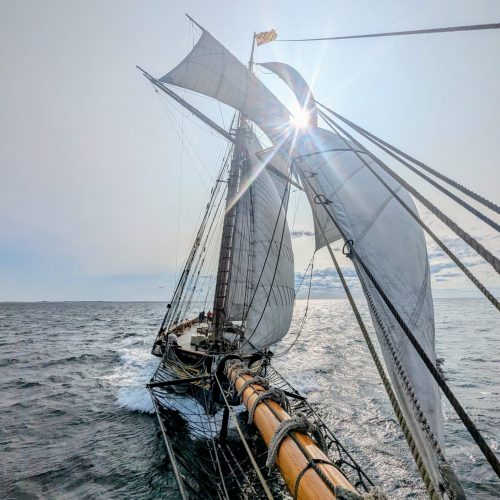15 September 2011
Pos: Alongside Jacques Cartier Basin, Montreal, Quebec
Wx: Overcast, cool, French
It is physically possible for Pride of Baltimore II’s passage from Hamilton, Ontario to the Iroquois Lock in the St. Lawrence River to have included more sailing, but only just. Having sailed off the dock in Hamilton Monday morning, we were less than a mile from the head of Burlington Bay, and when the foretops’l finally came in on Tuesday, 225 nautical miles and 27 hours later, the Iroquois lock was in sight. That’s an average speed of 8.25 knots. Our passage across the Lake took less than 20 hours, and at one stage the Vessel Traffic Control center at Seaway Sodus was concerned that at 11.5 knots we were going TOO FAST and would get to the Snell Lock before a pilot could be scheduled to meet us!
We assured the folks at the Seaway we would be slowing down once out of the open Lake, past Cape Vincent and into the river. We did, but only barely – with the breeze still favorable and help from the following current we carried on into the Thousand Islands area under four lowers and foretops’l. Near the town of Clayton, NY, we loaded our starboard guns for a salute. Earlier this season, I spent a week in Clayton while serving as relief Captain of Lynx, and discovered the town both loves ships of all kinds and is chock full of generous and hospitable folk. Event organizer Michael Folsom contacted Pride II via text message and alerted the town we’d be passing by, and Mayor Norma Zimmer, who sailed aboard Lynx from Ogdensburg to Clayton with me in the spring, was standing on the dock. We feathered up close enough to say hello and pass a warning that we’d be saluting, fired, then bore off to keep reaching down the river.
After passing Clayton, I began pondering just how far we could carry on under sail. We were making 8-10 knots, faster than we’d likely be motoring and the course up the river required just a few maneuvers, waring ship along the bends of the river to reduce the risk of accidentally gybing the mains’l. In the spring, I had the good fortune of being able to sail Lynx UP the river from Ogdensburg, NY to Clayton with a 25 knot North Easter, and then sail from Clayton half way across Lake Ontario to Rochester a week later. This gave no small personal motivation to be able to make a “round trip” of the upper river by sailing at least to Ogdensburg.
And Pride II did exactly that, carrying four lowers and the foretops’l to within sight of the Ogdensburg Prescott Bridge, before reducing to just the foretops’l. With more current in that section of the river, plus the wind increasing to near 40 knots, we kept making 10 knots until sighting Iroquois Lock, taking in the tops’l and firing up engines to Slow down. Unlike our approach to the SOO Locks in July, there was no safe way to sail into Iroquois with the breeze being what it was. In fact, it was workout enough to get Pride II pointed in the right direction and slowed down enough under power.
Once clear of the lock, we took advantage of the breeze, re-set the foretops’l and sailed clear to the American locks, right at the Canadian border. After securing precariously at the approach wall of the Eisenhower Lock for passing traffic, we got underway again at sunset, dropped down to the lower level and secured at the Snell Lock approach wall to wait for our pilot. Pride II has never required a pilot in the St. Lawrence Seaway before, but new Canadian regulations make it necessary, so we were forced to coordinate our passage with the 12 hour advance notice the Pilots require. By the time we boarded our first Pilot, the breeze had died down and the passage was made entirely under power. With no traffic to hold us up, we made the last lock, St. Lambert, at 1041, exchanged for a Harbor Pilot, and waited at anchor for the rest of the fleet to arrive and start the Parade of Sail.
As if on schedule for the parade, the skies cleared and the breeze became a nearly sailable SW. Not that sailing from the Longueuil Anchorage into the Jacques Cartier Basin would be possible except with ideal conditions – the Lachine Rapids, which the first locks of the St. Lawrence Seaway circumvent, have the current on the approach to the Basin running at 6 knots. The bouys to mark the channel have to be specially made so they aren’t swept under water and low horsepower vessels have a slow transit of the area. With thousands of people watching the procession of six sailing vessels, the slow approach must have created a sense of suspense. At 1630 sharp, Pride II ended the anticipation by firing a salute just off the basin. We even shifted a gun from port to starboard to add flair.
With all ships secure at the dock, we’re ready for a weekend of heavy traffic. Last year over 9,000 people came to see Pride II in just three days, and this year we’re here for four. I hope the crew have been brushing up on their French.
All best,
Jamie Trost and the crew of Pride of Baltimore II






